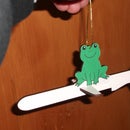Introduction: Rat Onna Stick
Everyone has a favourite street-food, and it's fair to say that anyone from Ankh-Morpork will remember Mr C.M.O.T. Dibbler's food with fondness^W clarity.
But if you've had to leave the city which holds all that life has to offer, then now you can recreate the authentic "Rat onna stick" experience.
With just a few simple ingredients, a 3-D printer and entirely too much hard work, you too can have a rat onna stick, with the added advantage that this version is hygienic, tastes good and can be dunked into tea.
Supplies
57g (1/4 cup) butter
1/2 cup white flour
3 tablespoons white sugar
extra flour for dusting
extra sugar for dusting
wooden skewers
mixing bowl
baking paper
3-D printer
(optional)
Icing for decorating
Step 1: How to Make a Rat
Use a rat-shaped biscuit cutter.
Despite the many advantages of living in NZ, one of the drawbacks is that the chain "Rat-Shaped Cookie Cutters 'R' Us" has yet to open up here, so we will have to make our own.
Step 1:- draw a rat
Step 2:- 3-D print it.
Unfortunately, I can't draw.
A phenomenal amount of trial and error produced the combination of geometric shapes which, when overlaid with each other form a rat shape.
I only had to draw two actual lines to make this rat, the rest being formed of ellipses, circles and triangles.
I have attached a .GIF so that you can see the components which made up the shape, an .SVG which shows the various features after removing unwanted lines and the .STL file which was used to print the pieces.
The .STL file was generated from TinkerCad.
The stamp portion of the file includes a tunnel through the middle which had been intended to hold a cable-tie, allowing a handle to be attached. The support structure from the printing kind of filled that in, but it wasn't needed in the end anyway.
Step 2: Print and Test
Big "ups" (as I believe the young people say) to the makerspace at the local library for printing out several iterations of the cutter while it was being perfected.
The second photograph shows the rat cutter beside a mouse (geddit?) for scale and also the cutter for a ninjabread man which was just too funny to not photograph.
Several different small-batch doughs were made and tried. There was a gingerbread which was delicious, and which stored for several days, but it spread too much during baking to retain a recognisable shape.
In general, and not for reasons of health, I think that lower-fat recipes will work better as they will spread less during cooking.
Once I'd found a recipe which retained its shape while baking, I tried making a batch with several different thicknesses as shown in the last photograph. About 6mm (1/4 inch) gave the best overall results, combining thorough cooking, no burning and a good contrast for the facial features.
Step 3: Making the Ideal Dough
This recipe is based on Joanie Zisk's at One Dish Kitchen. I tried several "small batch" recipes, before I found this one which worked.
https://onedishkitchen.com/small-batch-shortbread-...
Chop the butter into small cubes to make it easier to incorporate.
Put the sugar and butter in a bowl and get squishing with a fork.
Once they look like the third picture, add the flour and get squishing again.
After a very long time, there will be a collection of crumbs like in the sixth photograph.
Squish them all together into one ball ready for rolling.
Step 4: Cutting, Baking and Decorating
Dust a board and the rolling-pin with flour and roll out the dough to about 6mm (1/4 inch).
Press the cutter down to make the shape, and free it from the body of the dough.
Fit the stamp inside the cutter and press down hard.
Lift the cutter off, leaving the stamp holding the cut dough.
Carefully insert a skewer into the back of the rat making sure it is absolutely level and in the centre of the thickness.
Lift the biscuit (cookie) and skewer onto a piece of baking parchment on a baking sheet.
Repeat until all the dough is used, re-rolling as necessary.
Sift some sugar onto the dough shapes before putting them into the oven if you like: that adds a little crunch to the eating experience.
Bake at 165C (325F) for 13-15 minutes.
Lay on a wire rack to cool.
Once the biscuits (cookies) are cool, pipe a contrasting colour of icing onto the features. I have just discovered "Wilton Decorating Gel" and love it, mainly for the tiny, tiny nozzle which makes it easy to follow a thin line.
Step 5: Errors, Omissions and Lessons
All sorts of exciting things were learned during this project, so if I share them too then you won't make the same mistakes.
Soaking the skewers in water for a day before baking is a really good idea. Otherwise they add a certain "burning bamboo" aroma to the biscuits.
Getting the right dough is absolutely crucial, both to maintain the shape and to retain enough thickness in the baked product to provide a secure anchor for the wooden stick.
It is possible to mix a biscuit (cookie) dough with minimal equipment! Though it is probably a _lot_easier with a mixer.
Cooking your sausage and chips lunch in the oven at the same time as the biscuits does save time, but is not a good idea, unless you like sausage and chip flavoured shortbread.
If you cannot find a non-spreading dough which you like, then you could try making the ears larger as they seem to expand less than the body.
Make sure that your audience are Pratchett fans, or they won't think these are funny.

Participated in the
Build a Tool Contest















